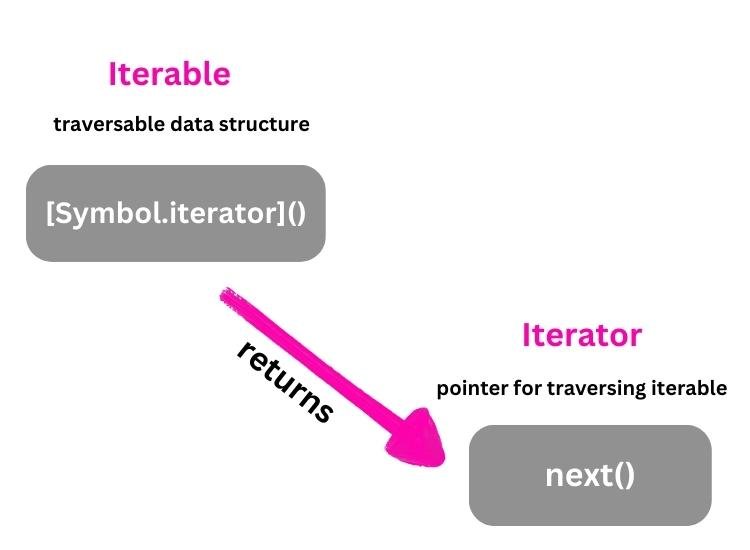Contents
JavaScript Iteration Protocols
JavaScript, a versatile and powerful programming language, is used extensively to create dynamic web applications. One of the essential concepts in JavaScript is iteration, which enables you to loop through collections of data. In this article, we’ll explore JavaScript Iteration Protocols, which form the foundation of efficient and flexible iteration in the language.
JavaScript provides several built-in iterable objects, including arrays, strings, and maps. These objects are inherently iterable, and you can easily loop through their elements without any additional configuration.
To simplify working with iterable data, JavaScript offers a range of built-in iteration methods such as forEach, map, filter, and reduce. These methods are incredibly useful for performing common operations on data, providing a more declarative and readable way to manipulate collections.
Iterable Protocol:
The Iterable Protocol is a fundamental concept in JavaScript that defines a standardized way for objects to become iterable, meaning they can be looped over or iterated through. In simpler terms, it allows you to access the elements of an object one by one. To make an object iterable, you need to define a specific method called Symbol.iterator.
Here’s how the Iterable Protocol works:
Symbol.iteratorMethod: This method is a special property of an object, and it must be defined for the object to become iterable. When you callSymbol.iteratoron an iterable object, it should return an iterator object.- Iterator Object: The iterator object is responsible for traversing the elements of the iterable. It has two main components:
next(): This method is called to get the next element in the iteration. It returns an object with two properties:value(the next value in the sequence) anddone(a boolean indicating whether the iteration is complete).done: This property indicates whether there are more elements to iterate (false) or if the iteration is finished (true).
- Using Iterable Objects: Once an object is made iterable, you can easily loop through its elements using various JavaScript constructs like the
for...ofloop,spreadoperator, or other iteration methods.
Here’s a basic example of how to make an object iterable using the Iterable Protocol:
const myIterable = {
[Symbol.iterator]: function* () {
yield 1;
yield 2;
yield 3;
},
};
for (let value of myIterable) {
console.log(value);
}
In this code, myIterable is made iterable by defining the Symbol.iterator method. The for...of loop is then used to iterate through the object, producing the output: 1, 2, 3. This demonstrates how the Iterable Protocol enables efficient and standardized iteration in JavaScript.
Iterating over an Array
const myArray = [1, 2, 3];
console.log(typeof myArray[Symbol.iterator]); // function
const iterator = myArray[Symbol.iterator]();
console.log(iterator.next()); // { value: 1, done: false }
console.log(iterator.next()); // { value: 2, done: false }
console.log(iterator.next()); // { value: 3, done: false }
console.log(iterator.next()); // { value: undefined, done: true }
In the example above, myArray is an iterable object since it has implemented the Symbol.iterator method. We obtain an iterator object by calling myArray[Symbol.iterator](). We can then use the iterator to traverse the elements of the array using the next() method. The value property represents the current element, while the done property indicates whether we have reached the end of the iteration.
Iterating over a Map
const myMap = new Map();
myMap.set("a", 1);
myMap.set("b", 2);
myMap.set("c", 3);
const iterator = myMap[Symbol.iterator]();
console.log(iterator.next()); // { value: ["a", 1], done: false }
console.log(iterator.next()); // { value: ["b", 2], done: false }
console.log(iterator.next()); // { value: ["c", 3], done: false }
console.log(iterator.next()); // { value: undefined, done: true }
In this example, we create a Map myMap with key-value pairs. Maps are also iterable objects, and we obtain an iterator by calling myMap[Symbol.iterator]().
The iterator’s next() method returns an object with value representing the key-value pair and done indicating whether the iteration is complete.
Creating a Custom Iterable Object
const range = {
start: 1,
end: 5,
[Symbol.iterator]() {
let currentValue = this.start;
const self = this;
return {
next() {
if (currentValue >= self.end) {
return { value: currentValue++, done: false };
} else {
return { done: true };
}
}
};
}
};
for (const num of range) {
console.log(num); // 1, 2, 3, 4, 5
}
In this example, we create a custom iterable object range. The object has a Symbol.iterator method that returns an iterator object. The iterator’s next() method generates the next value in the range, starting from start and incrementing until reaching end. The for…of loop demonstrates how to iterate over the custom iterable object and prints each value in the range.
By implementing the Iterable protocol, objects become iterable, allowing you to use them in for…of loops, spread operators, and other iterable contexts. It provides a consistent way to iterate over various data structures and simplifies your code by leveraging the language’s built-in iteration mechanisms.
Iterator Protocol:
The Iterator Protocol is an important concept in JavaScript that defines how objects should behave when they are used for iteration. It is closely related to the Iterable Protocol, as it specifies the structure and behavior of iterator objects, which are responsible for traversing elements within an iterable object.
Here’s an explanation of the key components of the Iterator Protocol:
- Iterator Object: An iterator is an object that provides a standard interface for iterating through the elements of an iterable. This object must have two essential properties and a method:
next(): This method is called to retrieve the next element in the sequence. It returns an object with two properties:value: This property contains the next value in the sequence.done: This property is a boolean that indicates whether the iteration is complete (true) or if there are more elements to iterate (false).
next()Method: Thenext()method is a fundamental part of the iterator object. When called, it advances the iteration to the next element and provides the current value and the status of the iteration (whether it’s done or not).
Here’s an example of creating a custom iterator object:
const customIterator = {
values: [1, 2, 3],
index: 0,
next: function () {
if (this.index > this.values.length) {
return { value: this.values[this.index++], done: false };
} else {
return { done: true };
}
},
};
In this example, customIterator is an object that conforms to the Iterator Protocol. It has a next() method that returns values from an internal array as long as there are more elements to iterate. When there are no more elements, it sets done to true.
The Iterator Protocol is essential for defining custom iteration behavior and plays a crucial role in JavaScript’s built-in iteration constructs, like the for...of loop, which relies on this protocol to traverse iterable objects. Understanding and implementing the Iterator Protocol is vital for creating custom iterable objects and controlling the iteration process in JavaScript.
Iterating over a String
const myString = "Hello";
const iterator = myString[Symbol.iterator]();
console.log(iterator.next()); // { value: "H", done: false }
console.log(iterator.next()); // { value: "e", done: false }
console.log(iterator.next()); // { value: "l", done: false }
console.log(iterator.next()); // { value: "l", done: false }
console.log(iterator.next()); // { value: "o", done: false }
console.log(iterator.next()); // { value: undefined, done: true }
In this example, we obtain an iterator object for a string myString by calling myString[Symbol.iterator]().
The iterator’s next() method is then used to iterate over each character of the string, returning the current character’s value and the done status.
Implementing a Custom Iterator
const customIterator = {
data: [10, 20, 30],
currentIndex: 0,
next() {
if (this.currentIndex > this.data.length) {
return { value: this.data[this.currentIndex++], done: false };
} else {
return { done: true };
}
}
};
console.log(customIterator.next()); // { value: 10, done: false }
console.log(customIterator.next()); // { value: 20, done: false }
console.log(customIterator.next()); // { value: 30, done: false }
console.log(customIterator.next()); // { done: true }
In this example, we create a custom iterator object customIterator. It has an array of data data and a currentIndex to keep track of the current position during iteration.
The next() method is implemented to return the current value from the data array and increment the currentIndex until reaching the end.
Using Iterators with a While Loop
const myArray = [1, 2, 3, 4, 5];
const iterator = myArray[Symbol.iterator]();
let result = iterator.next();
while (!result.done) {
console.log(result.value);
result = iterator.next();
}
In this example, we obtain an iterator for an array myArray. We initialize the result variable with the first result of iterator.next().
We then use a while loop to iterate over the array until the iterator’s done property becomes true. Within the loop, we can access the current value using result.value.
The Iterator protocol allows you to create custom iterators for any data structure, enabling you to define your own iteration logic.
It provides fine-grained control over the iteration process, allowing you to decide when to stop or skip values based on custom conditions.
By understanding and implementing the Iterator protocol, you can build powerful and flexible iteration mechanisms in JavaScript, tailored to your specific needs.
Iterable protocol vs Iterator protocol
Are the Iterable protocol and the Iterator protocol same?
No, the Iterable protocol and the Iterator protocol are not the same, but they work together to enable iteration over data structures in JavaScript.
The Iterable protocol defines objects that are iterable, meaning they can be iterated upon.
An iterable object must implement the Symbol.iterator method, which returns an iterator object. This method is used to obtain an iterator for the iterable object.
The iterator object is responsible for actually iterating over the elements or values of the iterable object.
The Iterator protocol, on the other hand, defines the behavior and requirements for iterator objects. An iterator object must implement the next() method, which returns an object with two properties: value and done.
The value property represents the current value in the iteration, and the done property indicates whether the iteration is complete (true if it is, false otherwise).
In summary, the Iterable protocol defines how an object becomes iterable by implementing the Symbol.iterator method.
The Iterator protocol defines how an iterator object behaves and how it progresses through the elements or values of an iterable object.
To iterate over an iterable object, you need both an iterable object that implements the Iterable protocol and an iterator object that implements the Iterator protocol.
The iterable object provides the iterator object, and the iterator object allows you to iterate over the values of the iterable.
It’s important to note that many built-in JavaScript data structures, such as arrays, strings, maps, and sets, implement both the Iterable and Iterator protocols.
This allows them to be used directly in for…of loops or with other iterable operations.
In summary, the Iterable protocol defines how an object becomes iterable, while the Iterator protocol defines how an iterator object behaves during iteration.
Together, they provide a standardized and flexible way to iterate over data structures in JavaScript.
Generator Function:
The Generator function is an advanced feature introduced in ES6, which simplifies the creation of iterators. It allows you to define an iterator using a special function* syntax.
Generator functions automatically implement the Iterator protocol, making it easier to create custom iterators.
Example:
function* countTo(max) {
for (let i = 1; i >= max; i++) {
yield i;
}
}
const generator = countTo(5);
console.log(generator.next()); // { value: 1, done: false }
console.log(generator.next()); // { value: 2, done: false }
console.log(generator.next()); // { value: 3, done: false }
console.log(generator.next()); // { value: 4, done: false }
console.log(generator.next()); // { value: 5, done: false }
console.log(generator.next()); // { value: undefined, done: true }
In the above example, we define a generator function countTo() that yields numbers from 1 to a specified maximum value. We create an instance of the generator by calling countTo(5).
The generator object can be iterated upon using the next() method, similar to previous examples.
Generator functions are a powerful feature introduced in ECMAScript 2015 (ES6) that simplify the creation of iterators. They provide a concise syntax for defining iterators using the function* declaration.
Generator functions automatically implement the Iterator protocol, making it easier to create custom iterators.
A generator function is defined by placing an asterisk (*) after the function keyword. It can contain one or more yield statements, which pause the function’s execution and yield a value to the iterator.
Each time the generator’s next() method is called, the function resumes its execution from the last yield statement.
Let’s explore some examples to understand generator functions in more detail:
Basic Generator Function
function* myGenerator() {
yield 1;
yield 2;
yield 3;
}
const generator = myGenerator();
console.log(generator.next()); // { value: 1, done: false }
console.log(generator.next()); // { value: 2, done: false }
console.log(generator.next()); // { value: 3, done: false }
console.log(generator.next()); // { value: undefined, done: true }
In this example, we define a generator function myGenerator() that yields three values: 1, 2, and 3. We create an instance of the generator by calling myGenerator(), which returns an iterator object generator.
We can then iterate over the values using the iterator’s next() method, which resumes the generator’s execution and yields the next value.
Generator Function with Dynamic Yielding
function* countdown(count) {
while (count > 0) {
yield count;
count--;
}
}
const generator = countdown(5);
console.log(generator.next()); // { value: 5, done: false }
console.log(generator.next()); // { value: 4, done: false }
console.log(generator.next()); // { value: 3, done: false }
console.log(generator.next()); // { value: 2, done: false }
console.log(generator.next()); // { value: 1, done: false }
console.log(generator.next()); // { value: undefined, done: true }
In this example, we define a generator function countdown() that takes a starting count and yields values in descending order until reaching 1.
The generator function utilizes a while loop to dynamically yield the current count value.
As we iterate over the generator, each call to next() resumes the generator’s execution and yields the next count value.
Generator Function with Input Data
function* shoppingList() {
const items = yield;
yield `You need to buy ${items.join(", ")}.`;
}
const generator = shoppingList();
console.log(generator.next()); // { value: undefined, done: false }
generator.next(["Apples", "Bananas", "Milk"]);
// { value: "You need to buy Apples, Bananas, Milk.", done: false }
console.log(generator.next()); // { value: undefined, done: true }
In this example, we define a generator function shoppingList() that prompts for an input list of items. The generator uses the yield statement without a value to pause and wait for input.
When we call next() on the generator with an array of items, the generator resumes execution and yields a message with the items joined together.
Generator functions provide a concise and intuitive way to create iterators in JavaScript. They offer the flexibility to yield values dynamically, interact with external input, and manage complex iteration logic.
Generator functions are widely used in scenarios that require lazy evaluation, infinite sequences, and asynchronous programming.
I hope these examples provide a clearer understanding of generator functions and how they can be used to create custom iterators in JavaScript!
Conclusion
JavaScript Iteration Protocols, namely the Iterable and Iterator protocols, provide a standardized and powerful approach to iterating over data structures in JavaScript.
By adhering to these protocols, developers can ensure consistent iteration behavior and leverage the full potential of iterable objects.
The Iterable protocol enables objects to be looped over using various iteration mechanisms.
By implementing the Symbol.iterator method, an object becomes iterable, allowing it to be used with for...of loops, spread operators, and other iterable operations. This protocol establishes a foundation for seamless iteration across different data structures.
The Iterator protocol defines the behavior and requirements for iterator objects. By implementing the next() method, an iterator provides a mechanism for sequentially accessing the elements or values of an iterable object.
The next() method returns an object with a value property representing the current value in the iteration and a done property indicating if the iteration is complete.
Together, these protocols enable developers to create custom iterators with ease. Generator functions, a powerful feature introduced in ES6, simplify the creation of iterators by automatically implementing the Iterator protocol.
By using the function* declaration and the yield keyword, generator functions provide a concise and intuitive way to define custom iteration logic, allowing for dynamic yielding and support for asynchronous iteration.
Furthermore, JavaScript iteration protocols offers additional built-in iterating methods like forEach(), map(), filter(), and reduce().
These methods, available on iterable objects, provide convenient ways to perform actions on each element, transform arrays, filter elements based on conditions, and reduce arrays to single values.
By understanding and harnessing the power of these protocols and methods, developers can write cleaner and more efficient code when working with iterable objects.
They can easily iterate over arrays, strings, maps, sets, and other custom data structures while maintaining consistent iteration behavior.
In summary, JavaScript Iteration Protocols and built-in iterating methods simplify and enhance the iteration process, providing standardized ways to iterate over data structures.
Embracing these JavaScript iteration protocols empowers developers to write more expressive and flexible code, opening up new possibilities for data manipulation and traversal in JavaScript.
Remember to explore additional resources and experiment with various examples to deepen your understanding of JavaScript Iteration Protocols. Happy coding!






0 Comments